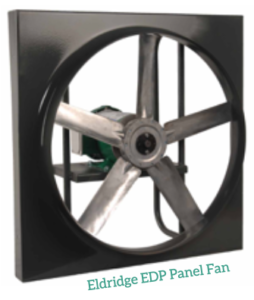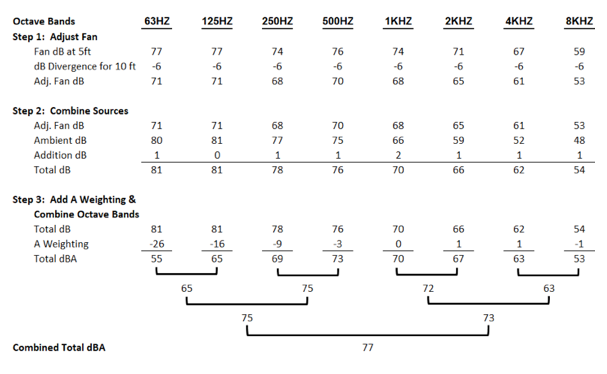ADDING FANS TO A NOISY ENVIRONMENT
When selecting fans for a customer’s application, we often hear, “Don’t select noisy fans.” What the customer really means to say is “Don’t make my shop floor noise problem any worse than it is.” Improving our customer’s work environment by adding cooling air flow wouldn’t be value added if everyone is now required to wear hearing protection. This article discusses how Eldridge analyzes the impact of adding fans to an already noisy environment and selects fans best fitting the application.
Preliminary Ventilation System Design
Measurement of ambient sound levels is the first step to finding a fan most beneficial to the application. However, placement of fans in a building is important in creating optimal air flow without contributing noise to the work environment. Eldridge begins our analysis by creating a preliminary ventilation system design. This allows an initial determination of fan locations to provide optimal air flow of the ventilation system. After fan placement is known, we make a preliminary fan selection. Ventilation system design is a necessary step to know the fan sound levels based on the fan size, propeller type, blade pitch and motor speed.
Ambient Conditions
Once the preliminary location of the new fan is marked on the building drawing, the process of measuring ambient sound conditions begin. A survey of the existing noise generating equipment is completed and locations are marked on the building drawing. Also, the location of obstacles in the building that may act as sound barriers or reflectors is noted. Knowing the location of sound sources, barriers and reflectors is useful later if adjustment of the new fan locations is needed.
The locations where sound measurements are taken and the equipment used to take the measurements are key to accurately determining ambient sound conditions. Sound pressure level measurements of existing sound generating equipment are best taken at the closest point to the location of each new fan where people may be present. For new fans that are to be located in the roof or high up on the walls, the closest point may be from the floor directly below the fan unless there is an elevated walkway closer to the fans.
Instead of using one combined sound level reading for each sound source, the best way to determine the effect of adding the sound level from a new fan to the ambient sound level is at each octave band. Therefore, the equipment used to take ambient sound level measurements should be capable of measuring sound levels in decibels (dB) for the 8 octave bands that cover most of the range of human hearing from 63HZ to 8KHZ.
Combining Sound Levels
Before combining the sound levels of the selected fan and ambient conditions, a distance adjustment needs to be made for the fan sound levels from the initial ambient sound measurement point. Sound levels dissipate by 6 dB for each doubling of the distance from the source. If the fan sound levels provided by the manufacturer were measured at 5 feet and the distance from our ambient sound measurement point to fan location is 10 ft, the distance has doubled. Therefore, the sound levels of the fan at each of the 10 octave bands should be reduced by 6 dB.
Sound levels aren’t added in the usual way because they are measured on a logarithmic scale. To calculate, we compare the difference between the highest and lowest octave band levels and add a factor to the highest level depending on the difference. Common practice for combining two octave band levels to find the total sound level uses the following:
- Difference of 0 to 1 dB: add 3 to the higher level to equal total sound level
- Difference of 2 to 4 dB: add 2 to the higher level to equal total sound level
- Difference of 5 to 9 dB: add 1 to the higher level to equal total sound level
- Difference of 10+ dB: add 0 to the higher level to equal total sound level
Here in an example calculation of combining the sound from one new fan to a work environment with an overall ambient sound level of 75 dBA at the point of measurement:

The calculation shows that the initial fan we selected will add 3 dB to the ambient sound level in the work environment. Since our goal was no increase in ambient sound level, options we will consider to reduce the contribution of the fan sound level include:
- Reduce the motor speed or blade pitch angle. In order to maintain the required airflow, we will either need to increase the size of each fan or increase the total number of fans.
- Move the location of the fan away from noise sources. It may be possible to calculate the affect, but should be confirmed with an ambient sound level measurement at the new fan location.
- Add silencers to the fans.
For this example, we initially selected a 36” fan with an 1170 rpm motor. By changing the selection to a 42” fan with an 870 rpm motor, we are able to reduce the fan sound level and achieve our goal of no increase in ambient sound level.
Conclusion
When considering increasing worker comfort and productivity, the benefits of adding more ventilation doesn’t need to be a trade-off for higher noise levels. Eldridge’s combined experience in ventilation and noise control allows us to provide an optimal, value added solution for your needs.

